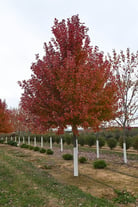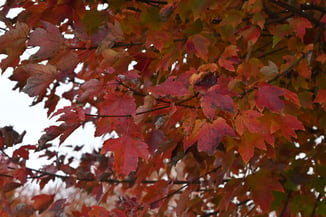This month, we’re celebrating one of North America’s most beloved and adaptable native trees — Acer rubrum, the Red Maple. Known for its stunning seasonal color, graceful shape, and hardiness across a wide range of conditions, this deciduous beauty shines in every landscape from spring through fall.
Featured Cultivars
 ‘Autumn Flame’
‘Autumn Flame’
Among the earliest to color each fall, ‘Autumn Flame’ shows off brilliant red-orange tones. Its strong branching and rounded form make it reliable and easy to maintain. 
 ‘Brandywine’
‘Brandywine’
A seedless cultivar with deep red to purple fall color. Compact and oval-shaped, it’s ideal for smaller landscapes or areas where seed cleanup is a concern.
‘October Glory’
A late-season favorite that holds its glossy green leaves longer before turning radiant crimson. It’s one of the most dependable maples for extended fall interest.
 ‘Red Sunset’
‘Red Sunset’
A classic choice known for its vivid orange-red fall color, upright form, and strong cold tolerance. Consistent and adaptable in a variety of conditions.
Each Red Maple cultivar delivers exceptional color, reliable shade, and valuable wildlife habitat in any setting — from urban streetscapes to naturalized plantings. With their unique timing and palettes of fall brilliance, there’s an Acer rubrum perfectly suited to every landscape vision.
At a Glance:
Zones: 4–9
Height: 40–60' (can reach up to 100')
Spread: 40–60'
Shape: Rounded to oval crown
Native Range: Eastern and Central North America
Sun: Full Sun to Part Shade
Water: Medium to wet — thrives in moist or swampy conditions
Maintenance: Low
Foliage: Deciduous
History of Acer rubrum
The Red Maple (Acer rubrum) has been a defining species in North America for centuries. Fossil evidence shows that maples have existed on the continent for tens of millions of years, and Acer rubrum itself is native to a vast range — from Newfoundland to Florida and west to Minnesota and Texas. Its adaptability to such varied climates and soils helped make it one of the most widespread and recognizable hardwoods in the eastern United States.
Early European settlers admired the Red Maple for its quick growth and beautiful fall color, often using it as a shade tree near homes and towns. Indigenous peoples had long appreciated it for practical and ceremonial purposes — its sap could be boiled for syrup, its wood carved for tools and handles, and its inner bark sometimes used in dyes and medicine.
In forestry, the Red Maple gained prominence through the 19th and 20th centuries for its ability to thrive on disturbed or low-lying land. It quickly became a valuable timber source for furniture, flooring, and veneer. As suburban and ornamental planting expanded through the mid-1900s, breeders began developing cultivars like ‘Red Sunset,’ ‘October Glory,’ and ‘Brandywine’ to enhance color consistency, form, and adaptability.
Today, Acer rubrum remains both an ecological workhorse and a landscape favorite. It provides early-season nectar for pollinators, brilliant fall foliage for homeowners, and resilient growth across nearly every region east of the Mississippi. Its legacy continues to evolve — a tree as rooted in history as it is in the modern landscape.
Seasonal Interest:
In early spring, the Red Maple awakens from dormancy with a delicate display of small but striking red flowers that emerge before the leaves. Male flowers attract bees and other pollinators, supporting local ecosystems, while female flowers develop into decorative red samaras that twirl gracefully to the ground in late spring, adding motion and interest to the landscape.
By summer, the tree’s foliage fills in fully, providing ample shade and texture. Leaves are 2–5 inches long, each with three to five pointed lobes and serrated edges, creating a dense, dappled canopy ideal for cooling patios, walkways, and yards. This lush greenery also offers habitat and forage for birds and beneficial insects.
As autumn approaches, the Red Maple transforms into a spectacular display of fall color, ranging from brilliant scarlet and deep crimson to fiery oranges and golds. Its early and vivid coloration often makes it one of the first trees to signal the arrival of fall, earning its reputation as a true seasonal showstopper.
Through winter, even after the leaves have dropped, the tree continues to provide visual interest. Its smooth, silvery bark offers a subtle contrast against bare branches and surrounding evergreens, while the sculptural form of the crown adds elegance to gardens, streetscapes, and naturalized areas.
Soil & Growth
Red Maples are celebrated for their adaptability. They thrive in a wide range of soils — from acidic to slightly alkaline — and perform particularly well in moist or low-lying areas, making them a strong choice for a variety of landscapes. Their cold-hardiness allows them to flourish across Zones 4–9, even in northern climates with harsh winters.
Because Waverly delivers mature, field-grown root ball trees, your Red Maple arrives with a naturally developed, dense root system that encourages rapid establishment. However, these trees are known for shallow, spreading roots, which can sometimes heave sidewalks or compact nearby soil. Giving the tree ample space to expand both above and below ground is essential.
When planting, ensure the root flare is visible and set at or slightly above soil level. This simple step prevents long-term decline and helps the tree thrive in its new location. With proper site selection, soil preparation, and planting technique, your Red Maple will establish quickly, grow strong, and provide decades of beauty and ecological value.
Potential Problems
While Red Maples are generally low-maintenance and hardy, they can occasionally face a few challenges. Common pests include aphids, leafhoppers, borers, scale insects, and caterpillars, which may cause minor leaf damage or sap issues. Fungal problems such as verticillium wilt, cankers, leaf spots, and root rot can occur, especially if the tree is stressed by poor drainage, compacted soil, or improper planting.
The tree’s branches can be somewhat delicate, making them prone to breakage during heavy wind, ice storms, or wet snow. To keep your Red Maple healthy, it’s important to maintain good soil conditions, ensure proper watering, and avoid planting too deeply. Regular pruning to remove weak or crossing branches not only reduces the risk of damage but also encourages strong, balanced growth.
With proper care and site selection, most Red Maples thrive for decades with minimal intervention, providing vibrant color and ecological value year after year.
Why Buy from Waverly Farm?
At Waverly Farm, we believe healthy landscapes start with strong foundations — and that begins in the field. Our Acer rubrum trees are mature, field-grown specimens, cultivated with space to develop deep, balanced root systems and sturdy branch structures long before they leave our farm.
By growing in the ground, opposed to containers, our trees experience natural soil conditions, temperature fluctuations, and seasonal cycles that strengthen their adaptability and resilience. When you plant a Waverly-grown tree, you’re not starting from scratch — you’re planting a tree that’s already been proven in the field.
This approach means less transplant shock, faster establishment, and long-term success in the landscape. It’s a difference you’ll see not just at planting time, but for decades to come.




